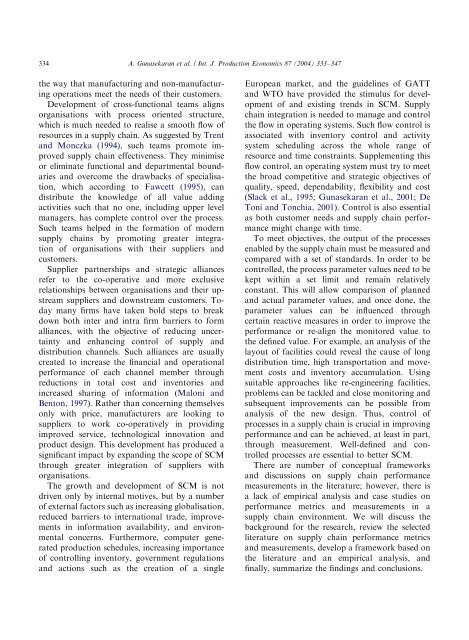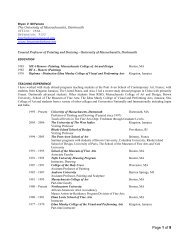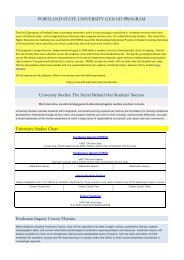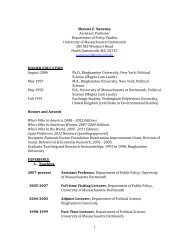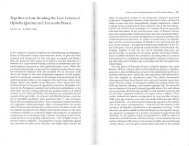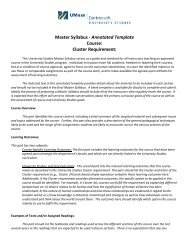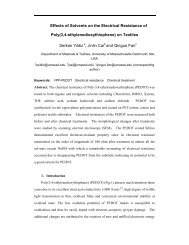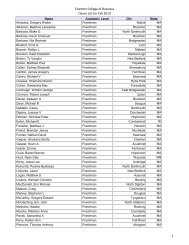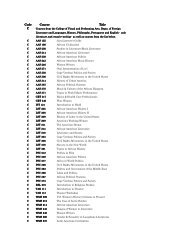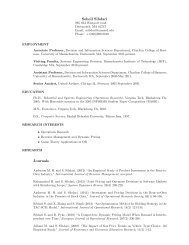A framework for supply chain performance measurement
A framework for supply chain performance measurement
A framework for supply chain performance measurement
Create successful ePaper yourself
Turn your PDF publications into a flip-book with our unique Google optimized e-Paper software.
ARTICLE IN PRESS334A. Gunasekaran et al. / Int. J. Production Economics 87 (2004) 333–347the way that manufacturing and non-manufacturingoperations meet the needs of their customers.Development of cross-functional teams alignsorganisations with process oriented structure,which is much needed to realise a smooth flow ofresources in a <strong>supply</strong> <strong>chain</strong>. As suggested by Trentand Monczka (1994), such teams promote improved<strong>supply</strong> <strong>chain</strong> effectiveness. They minimiseor eliminate functional and departmental boundariesand overcome the drawbacks of specialisation,which according to Fawcett (1995), candistribute the knowledge of all value addingactivities such that no one, including upper levelmanagers, has complete control over the process.Such teams helped in the <strong>for</strong>mation of modern<strong>supply</strong> <strong>chain</strong>s by promoting greater integrationof organisations with their suppliers andcustomers.Supplier partnerships and strategic alliancesrefer to the co-operative and more exclusiverelationships between organisations and their upstreamsuppliers and downstream customers. Todaymany firms have taken bold steps to breakdown both inter and intra firm barriers to <strong>for</strong>malliances, with the objective of reducing uncertaintyand enhancing controlof <strong>supply</strong> anddistribution channels. Such alliances are usuallycreated to increase the financialand operationalper<strong>for</strong>mance of each channelmember throughreductions in totalcost and inventories andincreased sharing of in<strong>for</strong>mation (Maloni andBenton, 1997). Rather than concerning themselvesonly with price, manufacturers are looking tosuppliers to work co-operatively in providingimproved service, technological innovation andproduct design. This development has produced asignificant impact by expanding the scope of SCMthrough greater integration of suppliers withorganisations.The growth and development of SCM is notdriven only by internal motives, but by a numberof externalfactors such as increasing globalisation,reduced barriers to internationaltrade, improvementsin in<strong>for</strong>mation availability, and environmentalconcerns.Furthermore, computer generatedproduction schedules, increasing importanceof controlling inventory, government regulationsand actions such as the creation of a singleEuropean market, and the guidelines of GATTand WTO have provided the stimulus <strong>for</strong> developmentof and existing trends in SCM. Supply<strong>chain</strong> integration is needed to manage and controlthe flow in operating systems. Such flow controlisassociated with inventory controland activitysystem scheduling across the whole range ofresource and time constraints. Supplementing thisflow control, an operating system must try to meetthe broad competitive and strategic objectives ofquality, speed, dependability, flexibility and cost(Slack et al., 1995; Gunasekaran et al., 2001; DeToni and Tonchia, 2001). Controlis also essentialas both customer needs and <strong>supply</strong> <strong>chain</strong> per<strong>for</strong>mancemight change with time.To meet objectives, the output of the processesenabled by the <strong>supply</strong> <strong>chain</strong> must be measured andcompared with a set of standards. In order to becontrolled, the process parameter values need to bekept within a set limit and remain relativelyconstant. This will allow comparison of plannedand actualparameter values, and once done, theparameter values can be influenced throughcertain reactive measures in order to improve theper<strong>for</strong>mance or re-align the monitored value tothe defined value. For example, an analysis of thelayout of facilities could reveal the cause of longdistribution time, high transportation and movementcosts and inventory accumulation. Usingsuitable approaches like re-engineering facilities,problems can be tackled and close monitoring andsubsequent improvements can be possible fromanalysis of the new design. Thus, control ofprocesses in a <strong>supply</strong> <strong>chain</strong> is crucial in improvingper<strong>for</strong>mance and can be achieved, at least in part,through <strong>measurement</strong>. Well-defined and controlledprocesses are essential to better SCM.There are number of conceptual<strong>framework</strong>sand discussions on <strong>supply</strong> <strong>chain</strong> per<strong>for</strong>mance<strong>measurement</strong>s in the literature; however, there isa lack of empirical analysis and case studies onper<strong>for</strong>mance metrics and <strong>measurement</strong>s in a<strong>supply</strong> <strong>chain</strong> environment. We will discuss thebackground <strong>for</strong> the research, review the selectedliterature on <strong>supply</strong> <strong>chain</strong> per<strong>for</strong>mance metricsand <strong>measurement</strong>s, develop a <strong>framework</strong> based onthe literature and an empirical analysis, andfinally, summarize the findings and conclusions.


